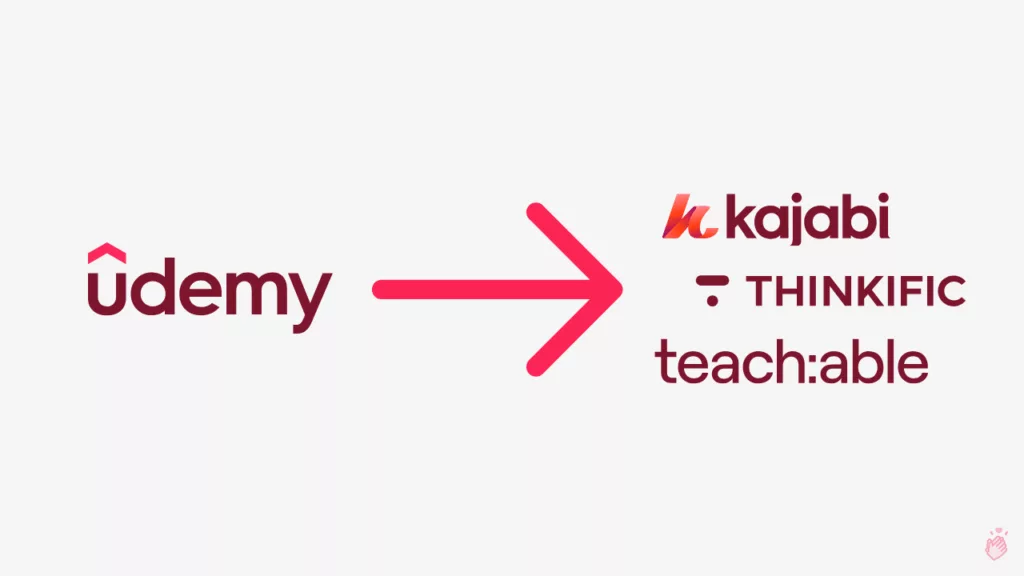Key Insights You Need to Know
For every customer who complains, 26 unhappy customers stay silent. Companies that actively analyze and implement customer feedback see nearly 10x greater annual revenue increases compared to those that don’t. Businesses that request and address feedback achieve 14% higher customer retention rates. Resolving negative feedback within 24 hours retains 80% of dissatisfied customers who would otherwise churn. Despite this, 53% of customers expect responses to negative reviews within a week, yet 87% of businesses fail to meet this expectation.
What Is Customer Feedback Management and Why Does It Matter?
Customer feedback management is the systematic process of collecting, analyzing, acting on, and communicating back about customer insights across all touch-points. It’s how you turn scattered complaints and comments into measurable business improvements.
Most businesses collect feedback but never act on it. They celebrate the absence of complaints while competitors win over silently dissatisfied customers. Structured feedback management changes this by creating a continuous loop that reduces churn, drives product innovation, and creates genuine competitive differentiation.
How Many Types of Customer Feedback Should You Collect?
You need both solicited and unsolicited feedback from direct and indirect channels. Relying on just one source gives you an incomplete picture.
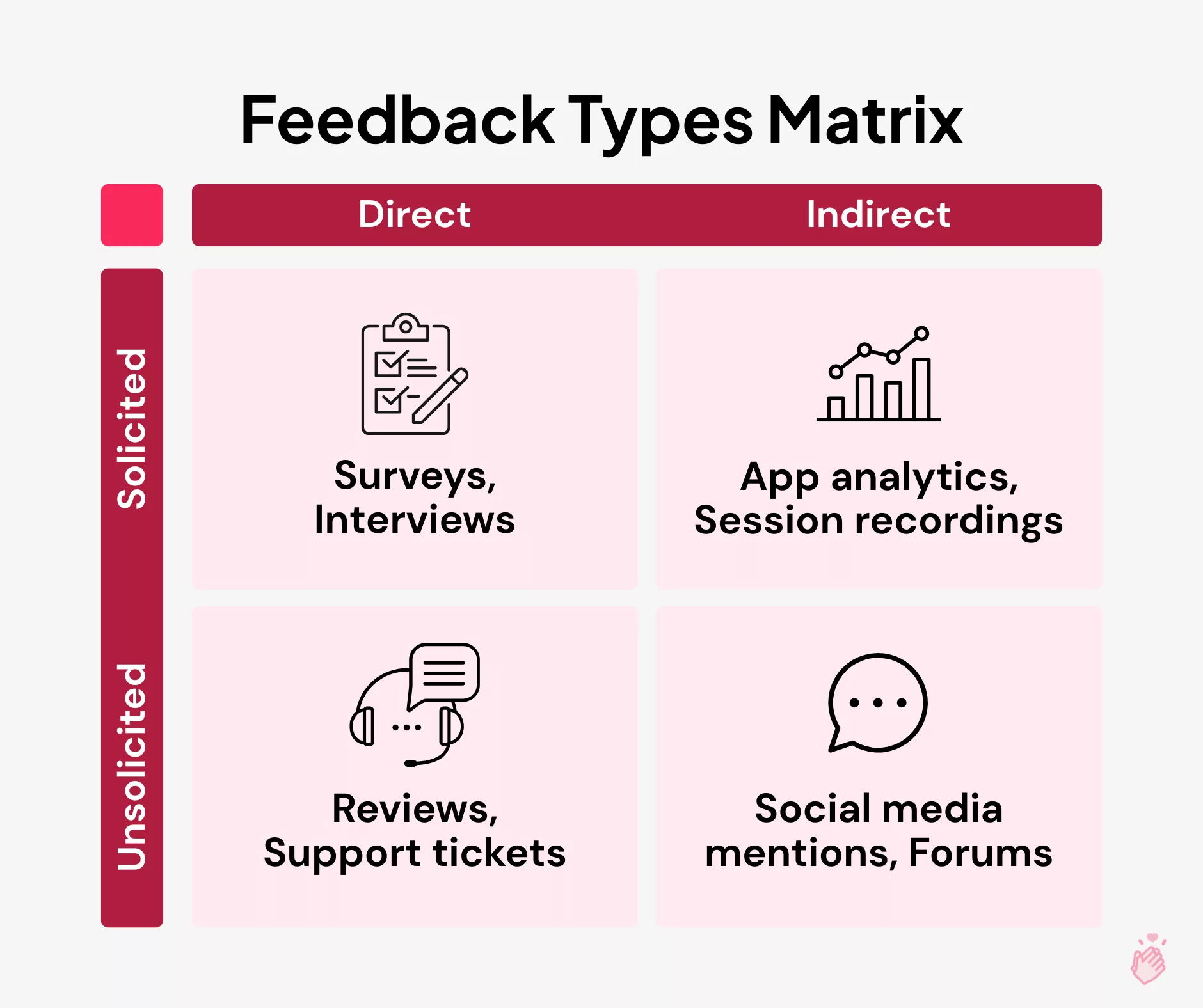
What’s the Difference Between Solicited and Unsolicited Feedback?
Solicited feedback comes from structured requests like surveys, interviews, and focus groups. It gives you targeted insights on specific topics but can suffer from response bias. Unsolicited feedback flows naturally from customer interactions without prompting—social media mentions, review site comments, support tickets, and spontaneous emails. This type reveals more authentic customer sentiments since customers share it voluntarily.
Research shows that 70% of consumers believe giving unsolicited feedback allows them to contribute meaningfully to product and service improvements. Both types are valuable: solicited feedback for targeted insights, unsolicited feedback for genuine emotions.
Which Channels Work Best: Direct vs Indirect Feedback?
Direct feedback comes through surveys, customer service calls, and face-to-face interactions. Indirect feedback emerges from behavioral data, social media monitoring, and third-party review platforms. The most successful companies use both approaches. Direct channels provide specific answers to business questions, while indirect channels reveal patterns and sentiments customers might not explicitly state.
How Does the Customer Feedback Loop Reduce Churn?
The customer feedback loop transforms complaints into competitive advantages through four essential steps: collect, analyze, act, and communicate back to customers.
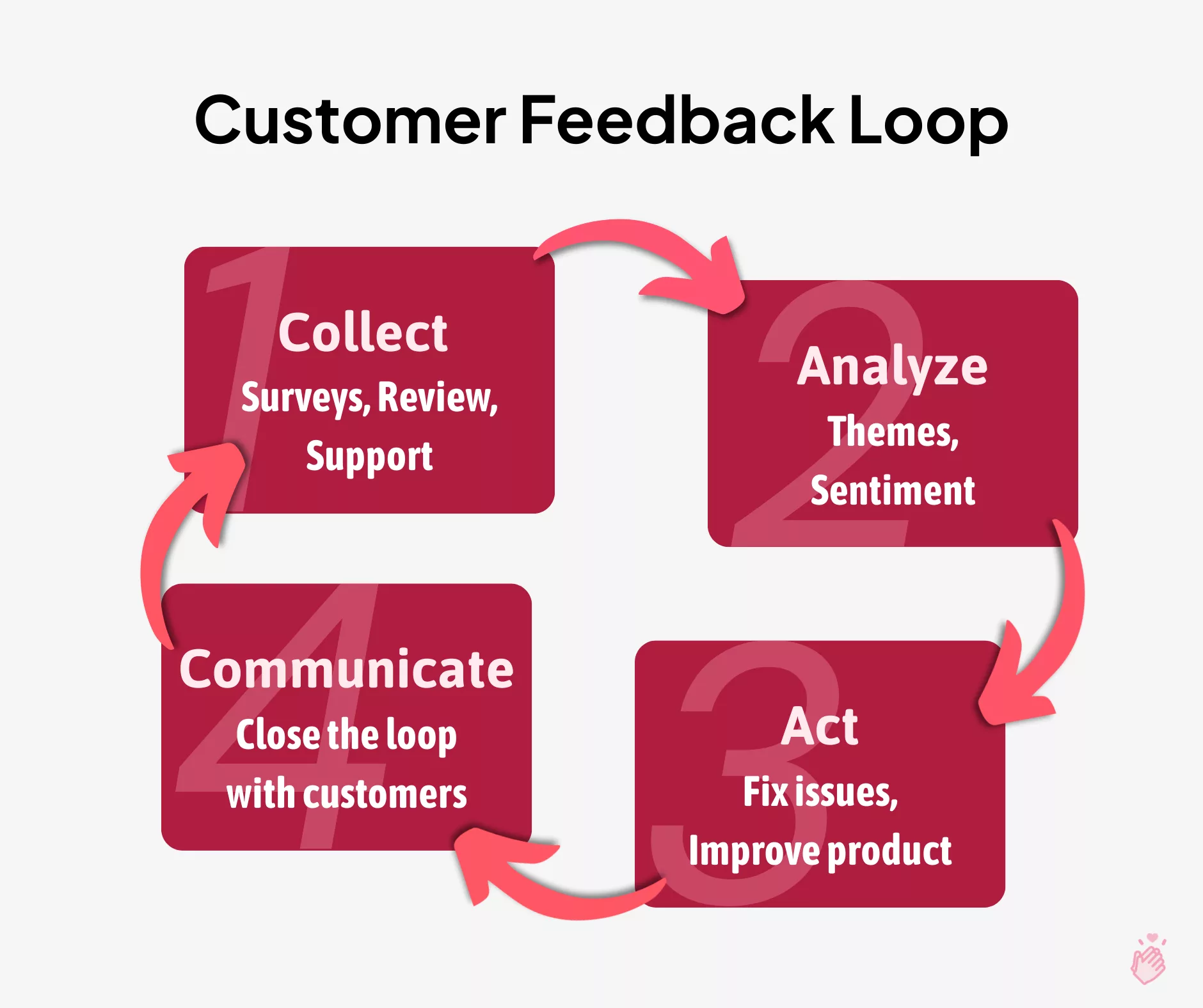
What Are the 4 Steps of an Effective Feedback Loop?
Step 1: Collect – Gather feedback through multiple touchpoints across the customer journey. The best systems capture insights through surveys, social listening, support interactions, and behavioral analytics.
Step 2: Analyze – Raw feedback means nothing without proper analysis. AI-powered sentiment analysis and theme detection help identify patterns across thousands of responses, revealing what manual review might miss.
Step 3: Act – Implementation separates successful companies from the rest. This step requires clear ownership, prioritization frameworks, and processes to turn insights into product improvements or service changes.
Step 4: Communicate – Closing the loop means telling customers what you’ve changed based on their input. This step builds trust and encourages future feedback participation.
How Quickly Should You Respond to Negative Feedback?
Speed matters. Resolving negative feedback within 24 hours retains 80% of dissatisfied customers who would otherwise churn. This is critical when 53% of customers expect businesses to respond to negative reviews within a week, yet 87% of businesses fail to meet this expectation.
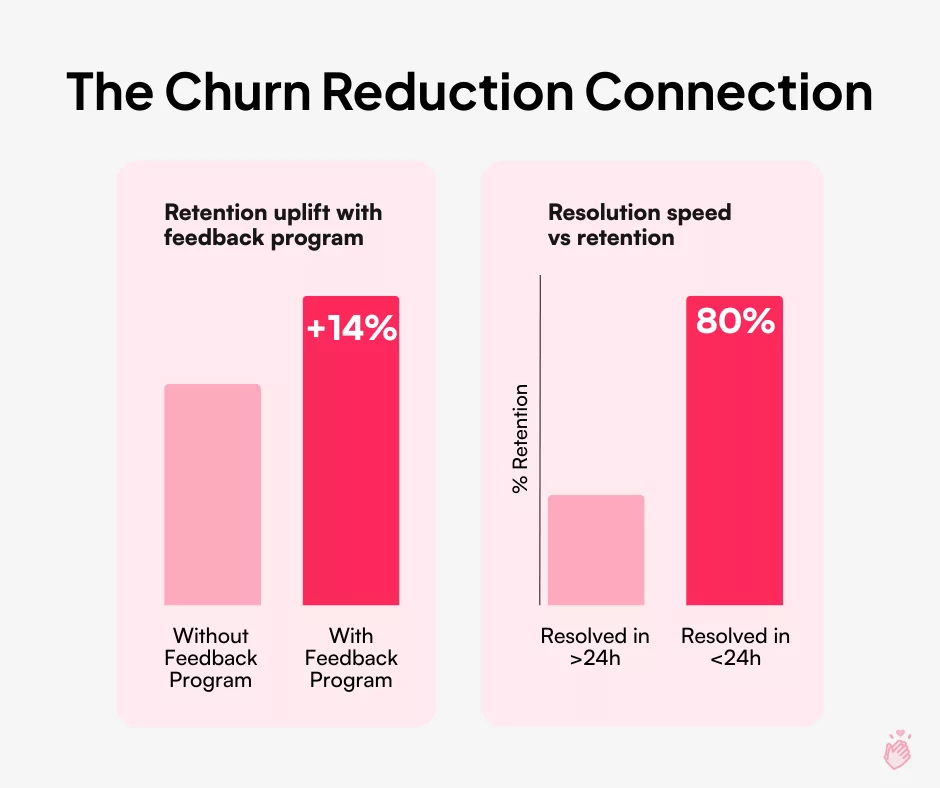
The gap between customer expectations and business response represents a massive opportunity for companies willing to close the feedback loop effectively.
What’s the Best Way to Collect Customer Feedback in 2025?
Multi-channel surveys have become the backbone of modern feedback collection. Rather than relying on a single method, successful companies deploy surveys across email, SMS, website pop-ups, and in-app notifications.
How Do You Get More Customers to Complete Your Surveys?
Make it ridiculously easy. If giving feedback feels like solving a complex puzzle, customers won’t participate. Use simple interfaces, mobile-friendly designs, and one-click rating systems whenever possible.
Time it right. Context matters more than convenience. Ask about the checkout experience immediately after purchase, not three weeks later. Request onboarding feedback after users complete key setup tasks.
Mix quantitative and qualitative approaches. Numbers provide measurable trends, while open-ended responses explain the “why” behind the data. Both are essential for complete understanding.
Leverage automated collection. Tools can trigger surveys based on customer behavior, send follow-up emails automatically, and collect feedback across multiple touchpoints without manual intervention.
Which Survey Channel Gets the Highest Response Rate?
Response rates vary dramatically by channel. Email surveys typically achieve 20-30% response rates, while in-app requests can reach 50%. Smart companies use this knowledge to match survey types with appropriate channels. Email works for detailed surveys, SMS captures quick pulse checks, and in-app surveys gather contextual feedback during active use.
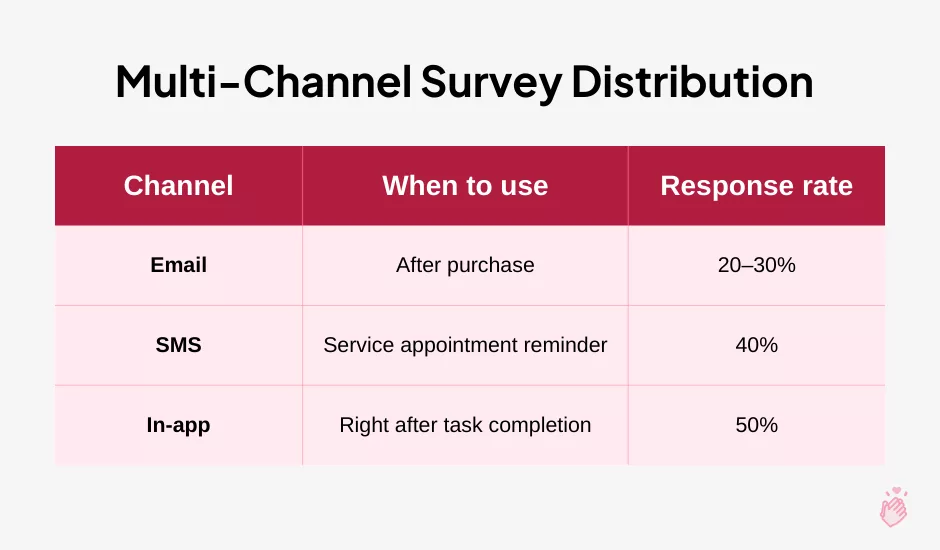
How Do You Analyze Customer Feedback at Scale?
Traditional manual analysis breaks down at scale. When feedback volumes reach thousands of responses monthly, AI survey tools and sentiment analysis become necessary, not optional.
Can AI Really Help Analyze Customer Feedback?
Natural Language Processing transforms unstructured feedback into actionable insights. Modern AI tools can automatically categorize responses, detect sentiment, and identify emerging themes across massive datasets.
AI sentiment analysis can process customer comments and immediately flag negative trends, allowing teams to respond before small issues become major problems. Companies using AI-powered analysis report 25% improvements in decision-making speed.
What’s More Important: NPS Scores or Customer Comments?
Customer satisfaction metrics like NPS, CSAT, and CES provide quantitative baselines, but they only tell part of the story. NPS measures loyalty likelihood, CSAT gauges satisfaction with specific interactions, and CES evaluates effort required to accomplish tasks.
The real insights emerge when you combine these metrics with qualitative feedback. A dropping NPS score becomes actionable when paired with open-ended responses explaining why customers feel less likely to recommend your service.
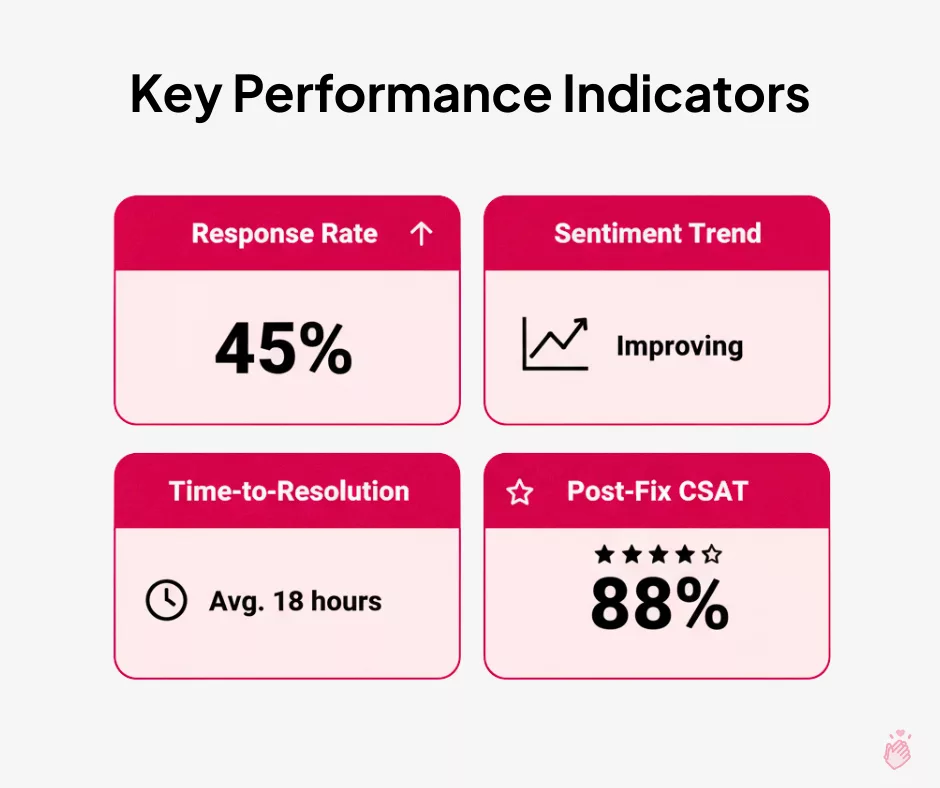
What Tools Do You Need for Customer Feedback Management?
AI-driven platforms are transforming how businesses handle customer feedback. These systems automatically collect responses, analyze sentiment, and route insights to appropriate teams for action.
How Should Feedback Tools Integrate With Your CRM?
The most powerful feedback management systems integrate with existing business tools. CRM integration allows feedback to be connected with customer profiles, support platform connections enable automatic ticket creation from negative feedback, and analytics integrations provide comprehensive customer journey insights.
This connected approach ensures feedback doesn’t exist in isolation but becomes part of broader customer intelligence efforts.
What Features Should You Look for in Feedback Dashboards?
Modern platforms excel at turning feedback into workflows. Automated routing sends product feedback to development teams, service complaints to support managers, and positive reviews to marketing teams for amplification.
Smart dashboards highlight urgent issues, track resolution progress, and measure the business impact of feedback-driven improvements. This automation ensures nothing falls through cracks while reducing manual overhead.
Key metrics to track include response rates by channel, sentiment trends over time, theme frequency, resolution time for feedback-driven issues, and customer satisfaction improvements following implemented changes.
What’s Next for Customer Feedback Management?
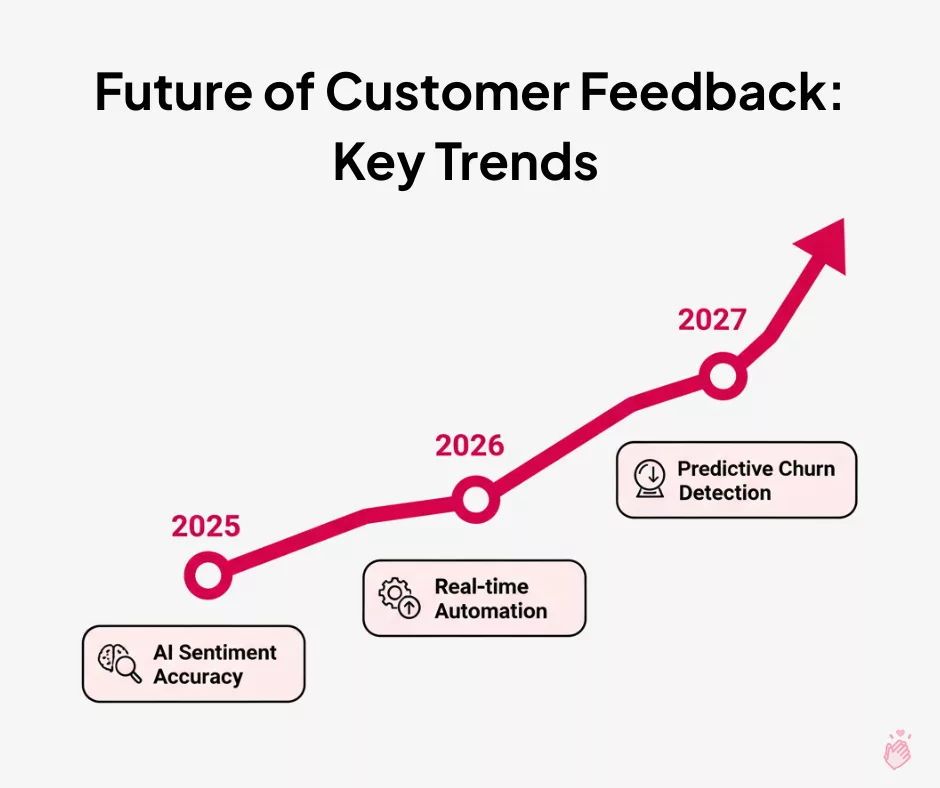
AI will continue advancing, making sentiment analysis more accurate and theme detection more sophisticated. Automated response systems will become more nuanced, and predictive analytics will help businesses anticipate customer needs before problems arise.
The companies winning in this environment are those that build comprehensive feedback systems today—collecting insights across channels, analyzing patterns with modern tools, and most importantly, acting quickly on what customers tell them.
Customer feedback management isn’t about perfect surveys or flawless processes. It’s about creating systems that turn customer voices into business improvements, faster and more effectively than your competition.
Quick Answers to Common Questions
How many unhappy customers don’t complain?
For every customer who complains, 26 unhappy customers remain silent.
What’s the revenue impact of acting on customer feedback?
Companies that actively implement customer feedback see nearly 10x greater annual revenue increases compared to those that don’t.
How much can feedback management improve retention?
Companies that request and address feedback experience 14% higher customer retention rates.
How fast should you respond to negative feedback?
Resolving negative feedback within 24 hours retains 80% of dissatisfied customers who would otherwise churn.
What response rate can I expect from email surveys?
Email surveys typically achieve 20-30% response rates.
Are in-app surveys more effective?
Does AI really speed up feedback analysis?
Companies using AI-powered analysis report 25% improvements in decision-making speed.
What percentage of customers expect weekly responses to negative reviews?
53% of customers expect businesses to respond to negative reviews within a week.
How many businesses meet that expectation?
Only 13% of businesses actually respond within a week, leaving 87% failing to meet customer expectations.



